Το 3DCoat διαθέτει ένα πολύ διαισθητικό και ολοκληρωμένο σύνολο στοιχείων ελέγχου και συντομεύσεων πληκτρολογίου για να σας βοηθήσει να χειριστείτε τον χώρο εργασίας σας και τις τρισδιάστατες σκηνές σας.
Προσπαθήσαμε να ενσωματώσουμε τις πιο κοινές συμβάσεις πλοήγησης που χρησιμοποιούνται στις πιο κοινές εφαρμογές 3D και δημιουργήσαμε τρόπους για να τις προσαρμόσουμε σχεδόν σε οτιδήποτε.
Viewport Navigation & Hotkey Assignment
* Χειριστήρια κάμερας και πλοήγηση στη θύρα προβολής : από τον Anton Tenitsky.
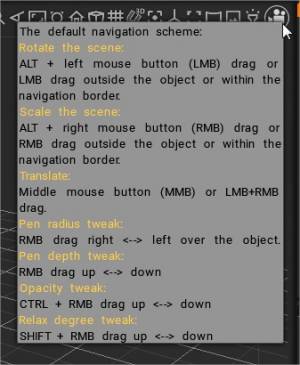
Κινήσεις κάμερας
Κοινές σε όλα τα δωμάτια είναι οι τυπικές μέθοδοι για την εμφάνιση της σκηνής σας και μεμονωμένων μοντέλων σε 3D Viewport. Εάν κρατήσετε πατημένο το πλήκτρο ALT/OPTION στη θύρα προβολής 3D και μετά σύρετε το LMB, η κάμερα περιστρέφεται γύρω από τη σκηνή. Εάν κρατήσετε πατημένο το πλήκτρο SHIFT, η κάμερα θα μεταβεί στο επόμενο επίπεδο πλαισίου.
Εάν κρατήσετε πατημένο το πλήκτρο ALT/OPTION, κάντε κλικ και κρατήστε πατημένο το και μετά σύρετε το RMB, η προβολή μεγεθύνεται ή μειώνεται ανάλογα με την κατεύθυνση κίνησης. Ταυτόχρονα, κρατώντας πατημένο το κουμπί ALT/OPTION και σύροντας το MBB, οι λειτουργίες προβολής. Δεδομένου ότι σχεδόν όλες οι συσκευές εισόδου χρησιμοποιούν την πλοήγηση με “ποντίκι” ως βάση για τον καθορισμό της χρήσης:
- Όταν δεν ενεργοποιείτε καμία από τις λειτουργίες εργαλείων του πίνακα “E”, σύροντας στον κενό χώρο στη θύρα προβολής ενώ κρατάτε πατημένο το αριστερό κουμπί του ποντικιού, η Κάμερα (η προβολή σας) περιστρέφεται γύρω από τη σκηνή.
- Όταν χρησιμοποιούνται εργαλεία του πίνακα “E” (ή ορισμένα συγκεκριμένα εργαλεία Voxel ), προσθέστε τον τροποποιητή πλήκτρων “Alt/Option” για να αποκτήσετε το ίδιο εφέ. Γενικά, όταν η μεταφορά προς τα αριστερά στη θύρα προβολής ΔΕΝ περιστρέφει την προβολή σας. Η ενεργοποίηση του τροποποιητή κλειδιού “Alt/Option” θα διορθώσει αυτό.
- Κρατώντας πατημένο το πλήκτρο “Shift” θα τραβήξετε την προβολή σε τακτά διαστήματα περιστροφής.
- Σύροντας στον κενό χώρο στη θύρα προβολής ενώ κρατάτε πατημένο το δεξί κουμπί του ποντικιού θα κάνετε μεγέθυνση ή σμίκρυνση της προβολής, ανάλογα με την κατεύθυνση κίνησης.
- Σύροντας στον κενό χώρο στη θύρα προβολής ενώ κρατάτε πατημένο το μεσαίο κουμπί του ποντικιού ή το κουμπί κύλισης θα μετατοπιστεί η προβολή.
Ρυθμίσεις κάμερας (αναπτυσσόμενο μενού)
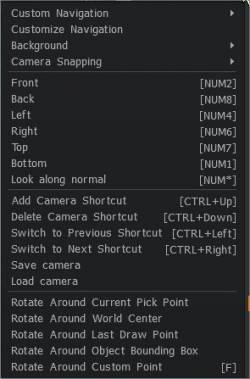
Ένα κλικ στο αναπτυσσόμενο βέλος “Κάμερα” στην επάνω δεξιά γωνία της διεπαφής θα σας δείξει ορισμένες επιλογές για την κάμερά σας, καθώς και τη χρήση προεπιλογών ή την προσαρμογή της πλοήγησης στο ίδιο το 3D Coat . Μπορείτε επίσης να δημιουργήσετε συντομεύσεις για τη θέση/περιστροφή της κάμερας για μελλοντική χρήση. Αυτές οι συντομεύσεις κάμερας αποθηκεύουν επίσης όλους τους τύπους 2D πλέγματος, σφραγίδας ή ρυθμίσεων θέσης/περιστροφής/κλιμάκωσης προτύπου, καθιστώντας εύκολη τη χρήση και την επαναχρησιμοποίηση εργαλείων με επαναλαμβανόμενα αποτελέσματα όταν χρειάζεται.
Μπορείτε να ορίσετε ένα σημείο περιστροφής για την περιστροφική πλοήγηση της κάμεράς σας πατώντας το “F”.
- Προσαρμοσμένη πλοήγηση: Επιλέξτε ανάμεσα σε στυλ πλοήγησης: 3DCoat, βέλη 3DCoat , Maya ή στυλ Zbrush .
Από προεπιλογή, έχει οριστεί το στυλ 3DCoat . Με το στυλ πλοήγησης 3DCoat , μπορείτε να περιστρέψετε τη σκηνή σας μετακινώντας το ποντίκι σας με το LMB πατημένο στην κενή περιοχή. Με τον ίδιο τρόπο, μπορείτε να μεγεθύνετε τη σκηνή σας με RMB και να μετακινήσετε με MMB. Εάν δεν θέλετε να μετακινήσετε τον κέρσορα στην άκρη, μπορείτε πάντα να χρησιμοποιήσετε τα ALT+LMB, RMB ή MMB για να περιηγηθείτε στη σκηνή.
- Προσαρμογή πλοήγησης: Ανοίγει έναν πίνακα που επιτρέπει την πλήρη προσαρμογή όλων των εντολών πλοήγησης. Μπορείτε να προσαρμόσετε την πλοήγηση σύμφωνα με τις δικές σας προτιμήσεις.
—-
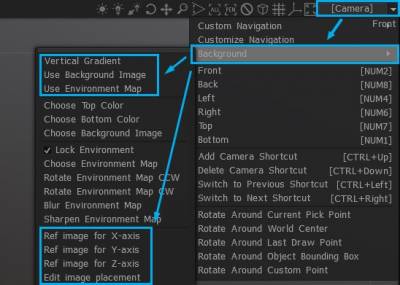
Υπάρχει επίσης ένα σύνολο επιλογών για την προσαρμογή του φόντου. Αυτές οι επιλογές είναι ως επί το πλείστον αυτονόητες. Αυτά που δεν είναι, ωστόσο, αναφέρονται αναλυτικά παρακάτω:
Φόντο: Ένα σύνολο επιλογών που σας επιτρέπει να ορίσετε μια ποικιλία προβολών φόντου ως οπτικές αναφορές. Το φόντο της θύρας προβολής γεμίζει το φόντο της θύρας προβολής 3D (και εκτείνεται για να γεμίσει, εάν χρειάζεται). Επιλέξτε Χρήση εικόνας φόντου και επιλέξτε την εικόνα σας από το άνοιγμα διαλόγου. Η προεπιλεγμένη εικόνα είναι ένα αστέρι. Οι Εικόνες αναφοράς μπορούν να χρησιμοποιηθούν για κάθε άξονα προβολής, X, Y και Z. Μπορείτε να επεξεργαστείτε την τοποθέτηση εικόνας για κάθε επίπεδο εικόνας σε κάθε άξονα με ένα γραφικό στοιχείο Transform. Μπορείτε να επεξεργαστείτε τη θέση, την κλιμάκωση, την περιστροφή και την προβολή της αδιαφάνειας.
Λήψη κάμερας:
Πίνακας πλοήγησης Ενημερώθηκε, νέα συμπεριφορά. Νέες λειτουργίες λήψης κάμερας:
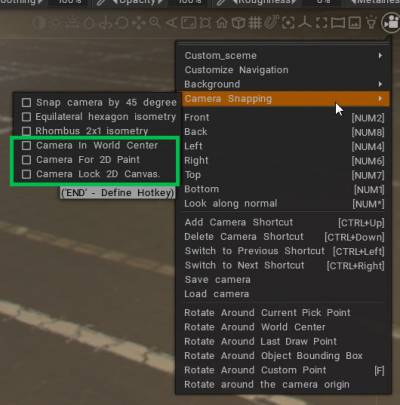
Σημεία περιστροφής
Υπάρχει ένας αριθμός επιλογών για να ορίσετε ένα σημείο περιστροφής για την περιστροφή σκηνής. Επιλέξτε αυτό που είναι πιο κατάλληλο για εσάς. Μπορείτε να καθορίσετε ένα σημείο περιστροφής για την περιστροφική πλοήγηση της κάμεράς σας (κέντρο κόσμου, σημείο επιλογής κ.λπ.).
- Rotate Around…: Αυτές οι εντολές ορίζουν το σημείο περιστροφής για την κάμερα προβολής.
Αποθηκεύστε τις θέσεις της κάμερας
Οι άλλες επιλογές σάς επιτρέπουν να διαγράψετε και να αλλάξετε αυτές τις αποθηκευμένες θέσεις της κάμερας.
- Προσθήκη συντόμευσης κάμερας: Οι πληροφορίες σχετικά με τη θέση της κάμερας και την τρέχουσα τοποθέτηση υλικού θα αποθηκευτούν. Μπορεί να χρησιμοποιηθεί για απόδοση ακολουθίας καρέ.
- Διαγραφή συντόμευσης κάμερας: Διαγραφή της τελευταίας συντόμευσης που χρησιμοποιήθηκε ή προστέθηκε.
- Εναλλαγή στην προηγούμενη συντόμευση: Μετάβαση στην προηγούμενη συντόμευση κάμερας και υλικού.
- Εναλλαγή στην επόμενη συντόμευση: Μετάβαση στην επόμενη συντόμευση κάμερας και υλικού.
Πίνακας πλοήγησης
Ο πίνακας πλοήγησης βρίσκεται στην επάνω δεξιά γωνία της θύρας προβολής. Αυτός ο πίνακας σάς δίνει πρόσβαση στις λειτουργίες πλοήγησης της θύρας προβολής, σε όλες τις ρυθμίσεις της κάμερας και στις λειτουργίες εστίασης, καθώς και στις ρυθμίσεις θέσης και έντασης φωτός της θυρίδας προβολής.
Από αριστερά προς τα δεξιά, αυτές είναι οι λειτουργίες κάθε εικονιδίου:

- Προσαρμόστε την αντίθεση του φωτισμού περιβάλλοντος: Είναι καλύτερα να αυξήσετε την αντίθεση για άνετη γλυπτική.
Κάντε διπλό κλικ για εναλλαγή μεταξύ δύο λειτουργιών:
- Η αντίθεση είναι μέγιστη, το περιβάλλον κλειδωμένο. Είναι καλό για γλυπτική.
- Η αντίθεση είναι ελάχιστη. το περιβάλλον είναι ξεκλείδωτο. Είναι καλό για απόδοση, ζωγραφική και οπτική εκτίμηση του αποτελέσματος.
- Προσαρμογή της έντασης φωτός: Κρατώντας πατημένο το LMB πάνω από αυτό το χειριστήριο και μετακινώντας το ποντίκι, προσαρμόστε την κύρια ένταση φωτός.
Υπάρχουν πολλές συμβουλές για να βελτιώσετε την εμπειρία σας στη γλυπτική.
Υπάρχει ένα εικονίδιο αντίθεσης επάνω δεξιά. Χρησιμοποιήστε το για να αυξήσετε την αντίθεση του φωτισμού. Η φυσικά σωστή εικόνα αντιστοιχεί στην αντίθεση 0, αλλά η μεγαλύτερη αντίθεση είναι πιο βολική για τη γλυπτική.
– Χρησιμοποιήστε Κάμερα→ Φόντο→ Κλείδωμα περιβάλλοντος για να κλειδώσετε το πανόραμα. Κάνει τις λεπτομέρειες της γλυπτικής πολύ καλύτερα ορατές.
– Χρησιμοποιήστε σκίαστρες PBR όποτε είναι δυνατόν και ρυθμίστε την κοιλότητα για να κάνετε τις λεπτομέρειες καλά ορατές. Μπορείτε να χρησιμοποιήσετε σκίαστρες MatCap, αλλά δεν τους συνιστούμε γιατί μόνο οι σκίαστρες PBR εγγυώνται ακριβές ψήσιμο και καλή χρωματική βαφή.
– Αντί να αυξήσετε χειροκίνητα την αντίθεση και να αλλάξετε το κλείδωμα πανοράματος, μπορείτε να κάνετε διπλό κλικ στο εικονίδιο αντίθεσης.
Χρησιμοποιήστε Προβολή→ Πανόραμα σε κλίμακα του γκρι για να προβάλετε χρώματα πάνω από το μοντέλο “ΩΣ ΕΧΕΙ” χωρίς έγχρωμες λυχνίες.
- Προσαρμογή γωνίας φωτός: Προσαρμόστε τη γωνία φωτός κρατώντας πατημένο το LMB πάνω από αυτό το στοιχείο ελέγχου και μετακινώντας το ποντίκι.
- Περιβάλλον θαμπώματος: Σύρετε για να θολώσετε/ευκρινίσετε την υφή του περιβάλλοντος στο φόντο της θύρας προβολής.
- Περιστροφή μπάλας ίχνους : Εναλλαγή μεταξύ δύο τρόπων περιστροφής – περιστροφή γύρω από τον κατακόρυφο άξονα ή ελεύθερη περιστροφή.
- Περιστροφή κάμερας: Κρατώντας πατημένο το LMB και μετακινώντας το ποντίκι. Για να περιστρέψετε την κάμερα χωρίς αυτό το χειριστήριο, χρησιμοποιήστε ALT+LMB (ή LMB πατημένο σε κενό χώρο). Σύρετε με το αριστερό κουμπί του ποντικιού για να προσαρμόσετε την προβολή του χρήστη περιστρέφοντας την κύρια κάμερα γύρω από το αντικείμενο που εστιάζεται.
- Μετακίνηση κάμερας: Κρατώντας πατημένο το Alt+LMB και μετακινώντας το ποντίκι. Σύροντας με το αριστερό κουμπί του ποντικιού, σύρετε την προβολή του χρήστη μετακινώντας την κύρια κάμερα δεξιά, αριστερά, πάνω και κάτω.
- Ζουμ κάμερας: Κρατώντας πατημένο το LMB και μετακινώντας το ποντίκι. Για να κλιμακώσετε τη σκηνή χωρίς αυτό το στοιχείο ελέγχου, χρησιμοποιήστε ALT+RMB (ή RMB πατημένο σε κενό διάστημα). Σύρετε το αριστερό κουμπί του ποντικιού προς τα δεξιά ή προς τα αριστερά για να μετακινήσετε την κύρια κάμερα πιο κοντά ή πιο μακριά από το εστιασμένο αντικείμενο.
- Αλλαγή οπτικού πεδίου: RMB για επαναφορά στην προεπιλεγμένη τιμή.
- Καδράρισμα της προβολής: Τοποθετήστε τη σκηνή ή το τρέχον αντικείμενο (στο δωμάτιο Sculpt) στο κέντρο του παραθύρου προβολής και κλιμακώστε το ώστε να χωράει γύρω από όλα τα ορατά αντικείμενα.
- Εστίαση στη βούρτσα: Εστιάστε την κάμερα στην επιφάνεια κάτω από τη βούρτσα. Η ακτίνα της βούρτσας θα καθορίσει την απόσταση από την επιφάνεια.
- Επαναφορά της κάμερας στην προεπιλεγμένη θέση: Μετάβαση στην προεπιλεγμένη ρύθμιση.
- Εναλλαγή προοπτικής/ορθογραφικής προβολής: Μπορείτε να επιλέξετε μεταξύ προοπτικής και ορθογραφικής προβολής.
- Πλέγμα: Εμφάνιση τρισδιάστατου πλέγματος.
- Σύρετε τον κέρσορα στην προβολή του τρισδιάστατου πλέγματος στην οθόνη : Εάν είναι ορατά πολλά πλέγματα, θα επιλεγεί το πιο περιστρεφόμενο προς την οθόνη. Συνιστάται η χρήση του σε ορθογώνια προβολή. Οι θέσεις και τα μεγέθη των Gizmos και των πρωτόγονων θα προσαρμόζονται σε διακριτές θέσεις στο διάστημα.
- Μετάβαση στην ορθογραφική προβολή και στιγμιότυπο: στην πλησιέστερη ακριβή προβολή σε αντιστοιχία με τις ρυθμίσεις «Κάμερα > Λήψη κάμερας».
- Εμφάνιση/Απόκρυψη άξονα
- Λειτουργεία πλήρους οθόνης
- Χάρτης περιβάλλοντος : Η υφή του χάρτη περιβάλλοντος που χρησιμοποιείται για να φωτίσει τη σκηνή. Κάντε κλικ στο κουμπί για να ανοίξετε ένα μίνι αναδυόμενο παράθυρο και να επιλέξετε έναν διαφορετικό χάρτη περιβάλλοντος.
- Εμφάνιση/Απόκρυψη εικόνων αναφοράς Αυτό το βίντεο δείχνει τη χρήση εικόνων αναφοράς. Είτε ως επίπεδα εικόνας στη θύρα προβολής είτε ως χρήση του Επιλογέα εικόνας ως στατικής εικόνας αναφοράς στο περιβάλλον εργασίας χρήστη.
- Viewport Projector : Μπορείτε να προβάλλετε οποιαδήποτε υφή σε ολόκληρη τη σκηνή, παρόμοια με τον προβολέα. Αυτό είναι απλώς για αναφορά, δεν επηρεάζει τις ιδιότητες χρώματος ή υλικού.
- Ο Προβολέας μπορεί να εφαρμοστεί χρησιμοποιώντας τις πίσω όψεις απομάκρυνση + ξεθώριασμα (προαιρετικό).
Συμβουλή Χάρτη Περιβάλλοντος (από τον Psmith): Το μόνο αποδεκτό για το 3DCoat για πανοραμικές εικόνες (μέσω του “+” στο κάτω μέρος του αναπτυσσόμενου μενού “Χάρτης περιβάλλοντος”) είναι οι σφαιρικές πανοραμικές εικόνες σε μορφή .exr.
Τα βήματα για να προσθέσετε τους δικούς σας σφαιρικούς πανοραμικούς χάρτες περιβάλλοντος HDR στο 3DCoat (για Sculpting και Rendering) είναι τα εξής:
- 1) Αποκτήστε μια σφαιρική πανοραμική εικόνα (σε απευθείας σύνδεση ή αλλού) σε μορφές εικόνας HDRI: (.exr, .hdr)
- 2) Μόλις ανοίξει και εκτελεστεί το 3DCoat (εργάζεται στο Sculpt Room, για παράδειγμα) – κάντε κλικ στο εικονίδιο ακριβώς στα αριστερά του εικονιδίου Κάμερα στην επάνω δεξιά γωνία της θύρας προβολής.
- 3) Κάντε κλικ στο «+» στο κάτω μέρος της στήλης μικρογραφιών και επιλέξτε τη σφαιρική πανοραμική εικόνα που είναι σε μορφή .exr ή .hdr – και περιμένετε να τη φορτώσει το 3D-Coat . Πείτε “OK” στο παράθυρο διαλόγου 3D-Coat που εμφανίζεται.
- 4) Προσαρμόστε τόσο την “Έκθεση” και την “Αντίθεση” της εικόνας που εμφανίζεται τώρα στη θύρα προβολής – χρησιμοποιώντας τα εικονίδια από τη σειρά των στοιχείων ελέγχου στην επάνω δεξιά γωνία της θύρας προβολής.
Πλοήγηση με χρήση tablet με στυλό
Η πλοήγηση εντός της θύρας προβολής 3D είναι πραγματικά διαισθητική και άνετη όταν χρησιμοποιείτε γραφίδα. ο έλεγχος και η πλοήγηση του ποντικιού είναι τα ίδια για μια γραφίδα όπως και για το ποντίκι που αναφέρθηκε παραπάνω.
- Πατήστε και σύρετε έξω από το μοντέλο (σε κενό χώρο) για να περιστρέψετε την προβολή κάμερας.
- Πατήστε και σύρετε δεξιά ή αριστερά κρατώντας πατημένο το κουμπί “Δεξί ποντίκι” (σε κενό χώρο) για μετατόπιση της προβολής.
- Τοποθετήστε το δείκτη του ποντικιού στον κενό χώρο κρατώντας πατημένο το κουμπί “Δεξί ποντίκι” και σύρετε για να μεγεθύνετε την προβολή.
Οι ρυθμίσεις Brush είναι εξίσου διαισθητικές:
- Τοποθετήστε το δείκτη του ποντικιού πάνω από το μοντέλο και σύρετε προς τα δεξιά ή προς τα αριστερά κρατώντας πατημένο το κουμπί που έχει εκχωρηθεί στο RMB για να αλλάξετε το μέγεθος του Brush.
- Τοποθετήστε το δείκτη του ποντικιού πάνω από το μοντέλο και σύρετε προς τα πάνω ή προς τα κάτω με το RMB πατημένο για να προσαρμόσετε το Βάθος της Brush.
Εικόνες φόντου
Υπάρχουν δύο διαφορετικά είδη φόντου: αυτά που απλώς γεμίζουν το φόντο της θύρας προβολής 3D (και εκτείνονται για να γεμίσουν, εάν χρειάζεται) και εκείνα που ρυθμίζονται χειροκίνητα για χρήση ως γλυπτική ή ζωγραφική εικόνων αναφοράς.
Viewport Background: Επιλέξτε Χρήση εικόνας φόντου και επιλέξτε την εικόνα σας από το άνοιγμα διαλόγου. Η προεπιλεγμένη εικόνα είναι ένα αστέρι.
Ή αν θέλετε να αντιστοιχίσετε μια εικόνα στο φόντο της διεπαφής, μπορείτε να αντιστοιχίσετε μια από τον σκληρό σας δίσκο.
Ανοίξτε το επάνω μενού και ανοίξτε Επεξεργασία→ Προτιμήσεις. Κάντε κύλιση προς τα κάτω, εντοπίστε την επιλογή Τύπος φόντου και κάντε κλικ στο αναπτυσσόμενο βέλος για να επιλέξετε την εικόνα Χρήση φόντου.

Από προεπιλογή, θα δείτε ένα φόντο που μοιάζει με πεδίο αστεριού. Μπορείτε, φυσικά, να επιλέξετε το δικό σας αρχείο κάνοντας κλικ στο πεδίο αίτησης αρχείου.
Εικόνες αναφοράς θυρών προβολής
Μερικές φορές θα χρειαστεί να δημιουργήσετε ένα μοντέλο που πρέπει να συμμορφώνεται με τις ακριβείς προδιαγραφές.
Εδώ είναι χρήσιμη η τοποθέτηση αυτών των τύπων εικόνων αναφοράς. Οι Εικόνες Αναφοράς μπορούν να τοποθετηθούν σε οποιονδήποτε άξονα της επιλογής σας X, Y ή Z. Μπορείτε ακόμη και να αντιστοιχίσετε μια διαφορετική εικόνα σε κάθε άξονα, ώστε να έχετε μια άποψη του έργου τέχνης σας ανεξάρτητα από τον άξονα από τον οποίο τυχαίνει να εργάζεστε.
Κάντε κλικ στο βέλος δίπλα στα χειριστήρια της κάμερας και, στη συνέχεια, επιλέξτε Φόντο→ Επιλογή εικόνας αναφ.
Μόλις κάνετε κλικ στο μενού, θα πλοηγηθείτε στον σκληρό σας δίσκο για μια εικόνα που θα χρησιμοποιηθεί κατά μήκος του άξονα Z. Η εικόνα που θα επιλέξετε θα εμφανιστεί στο κύριο παράθυρο του 3DCoat. Επίσης, θα εμφανιστεί ένα αναδυόμενο μενού με εργαλεία τοποθέτησης και κλιμάκωσης.
Χρησιμοποιήστε τα εργαλεία κατά μήκος της εικόνας σας ή το αναδυόμενο μενού εικόνων αναφοράς για αλλαγή μεγέθους, αλλαγή θέσης ή εμφάνιση και απόκρυψη της εικόνας.
Μπορείτε ακόμη και να αλλάξετε την αδιαφάνεια της εικόνας, ώστε να είναι πιο εύκολο να εστιάσετε στις εργασίες μοντελοποίησης σας.

Ας ρίξουμε μια ματιά στον τρόπο αντιστοίχισης εικόνων σε οποιονδήποτε άξονα.
Επιλέξτε εικόνες αναφοράς : Οι τρεις επιλογές στο κάτω μέρος σας επιτρέπουν να επιλέξετε τρεις ξεχωριστές εικόνες – 1 για κάθε άξονα προβολής, X, Y και Z.
Επεξεργασία τοποθέτησης εικόνας: Όταν είναι επιλεγμένη, αυτή η επιλογή παρέχει σε κάθε επίπεδο εικόνας σε κάθε άξονα ένα γραφικό στοιχείο Transform και συνοδευτικές ρυθμίσεις διαλόγου για την προσαρμογή της θέσης, της κλίμακας, της περιστροφής και της αδιαφάνειας προβολής.
Σημειώσεις για τη χρήση των επιπέδων εικόνας : Αυτό το βίντεο προσθέτει πρόσθετες σημειώσεις που πρέπει να λάβετε υπόψη όταν χρησιμοποιείτε Επίπεδα εικόνας αναφοράς.
Χρήση εικόνων αναφοράς : Αυτό το βίντεο δείχνει τη χρήση εικόνων αναφοράς. Είτε ως επίπεδα εικόνας στη θύρα προβολής είτε ως χρήση του Επιλογέα εικόνας ως στατικής εικόνας αναφοράς στο περιβάλλον εργασίας χρήστη.
Αναφορά και ταπετσαρίες
Το φόντο του Viewer γεμίζει το φόντο του 3D Viewer. Επιλέξτε Χρήση εικόνας φόντου και επιλέξτε την εικόνα σας από το παράθυρο διαλόγου που ανοίγει. Η προεπιλεγμένη εικόνα είναι ένα πεδίο αστέρι. Οι εικόνες αναφοράς μπορούν να χρησιμοποιηθούν για κάθε άξονα προβολής X, Y και Z. Μπορείτε να επεξεργαστείτε την τοποθέτηση εικόνας για κάθε επίπεδο εικόνας σε κάθε άξονα με ένα γραφικό στοιχείο μετασχηματισμού. Μπορείτε να επεξεργαστείτε τη θέση, την κλιμάκωση, την περιστροφή και την αδιαφάνεια της προβολής.
* Σκίαση θυρών προβολής, εναλλαγή φόντου, επίπεδα αναφοράς : από τον Anton Tenitsky.
FAQ
Όταν έσυρα μια εικόνα αναφοράς στο 3DCoat, μου δόθηκαν ορισμένα στοιχεία ελέγχου μενού, αλλά δεν φαίνεται να υπάρχει τρόπος να τα επαναφέρω. Πώς μπορώ λοιπόν να προσαρμόσω τις εικόνες αναφοράς;
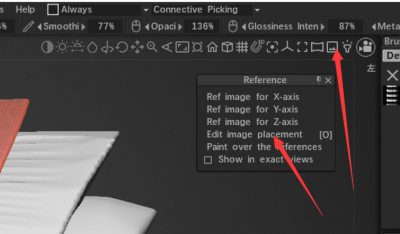
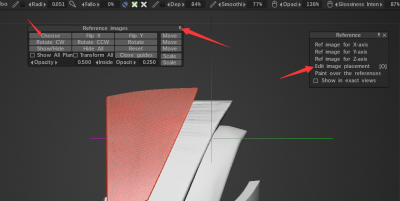
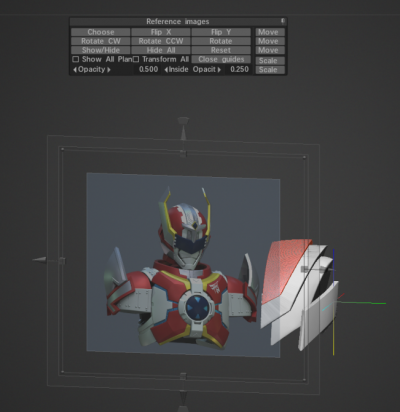
* Κάντε κλικ εδώ για να αποκρύψετε το cross gizmo.
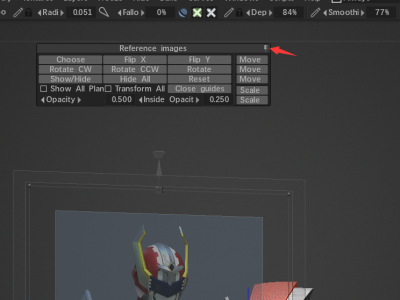
Ευχαριστώ, Nick-LF.
Κάμερα και προσαρμοσμένη πλοήγηση
Τα πλήκτρα συντόμευσης ορθογραφικών προβολών είναι μπροστά, πίσω, αριστερά, δεξιά, επάνω και κάτω και κανονικά κοιτάξτε κατά μήκος .
NumPad 2 μπροστά
NumPad 8 Πίσω
NumPad 4 αριστερά
NumPad 6 Δεξιά
NumPad 7 Top
NumPad 1 Κάτω
Ctrl+Πάνω βέλος Προσθήκη συντόμευσης κάμερας
Ctrl+Κάτω βέλος Διαγραφή συντόμευσης κάμερας
Ctrl+Αριστερό βέλος Μετάβαση στην προηγούμενη συντόμευση
Ctrl+Δεξί βέλος Μετάβαση στην επόμενη συντόμευση
Προσαρμόστε την εμπειρία σας στο 3DCoat
Μπορείτε να αντιστοιχίσετε συντομεύσεις ενός και πολλαπλών κουμπιών σε σχεδόν οποιαδήποτε λειτουργία ή εργαλείο 3DCoat απευθείας στη διεπαφή χρήστη. Απλώς πατήστε το πλήκτρο ΤΕΛΟΣ ενώ μετακινείτε το ποντίκι πάνω από οποιοδήποτε στοιχείο, ακολουθούμενο από τη συντόμευση πληκτρολογίου της επιλογής σας.
Εάν διαπιστώσετε ότι χρησιμοποιείτε σπάνιες ή ποτέ συγκεκριμένες, ασαφείς λειτουργίες της εφαρμογής, επιλέξτε Προσαρμογή διεπαφής χρήστη από το μενού Επεξεργασία και απενεργοποιήστε τυχόν στοιχεία που δεν θέλετε πλέον να εμφανίζονται στη διεπαφή χρήστη για να αποφύγετε την ανεπιθύμητη ακαταστασία.
Χρησιμοποιήστε την επιλογή Επεξεργασία/Προτιμήσεις για να προσαρμόσετε το συνδυασμό χρωμάτων και την εμφάνιση ολόκληρης της διεπαφής 3DCoat .
Φροντιστήρια
Πώς να αλλάξετε την ταχύτητα ζουμ της κάμερας : Θα μάθετε πώς να αλλάζετε την ταχύτητα της κάμερας προβολής μέσα στο 3DCoat. Του Κρίστοφ Βέρνερ.
Γρήγορη συμβουλή: Κέντρα περιστροφής κάμερας : Αυτό το βίντεο Γρήγορης συμβουλής δείχνει τα 2 Κέντρα περιστροφής κάμερας που θα θέλει να γνωρίζει ο χρήστης του 3DCoat , καθώς είναι πιο ωφέλιμα σε ορισμένα σενάρια.
Εναλλαγή περιστροφής πλοήγησης και εικονίδιο εικόνας αναφοράς : Αυτό το βίντεο δείχνει τις πρόσφατες προσθήκες στη γραμμή πλοήγησης στο 3DCoat.
Επιλογές χάρτη περιβάλλοντος HDR : Αυτό το βίντεο καλύπτει μια σειρά από νέες επιλογές για την προεπισκόπηση και τη χρήση ενός χάρτη περιβάλλοντος HDR σε μια σκηνή τόσο για φωτισμό όσο και για φόντο.
 Ελληνικά
Ελληνικά  English
English Українська
Українська Español
Español Deutsch
Deutsch Français
Français 日本語
日本語 Русский
Русский 한국어
한국어 Polski
Polski 中文 (中国)
中文 (中国) Português
Português Italiano
Italiano Suomi
Suomi Svenska
Svenska 中文 (台灣)
中文 (台灣) Dansk
Dansk Slovenčina
Slovenčina Türkçe
Türkçe Nederlands
Nederlands Magyar
Magyar ไทย
ไทย हिन्दी
हिन्दी Tiếng Việt
Tiếng Việt Lietuviškai
Lietuviškai Latviešu valoda
Latviešu valoda Eesti
Eesti Čeština
Čeština Română
Română Norsk Bokmål
Norsk Bokmål